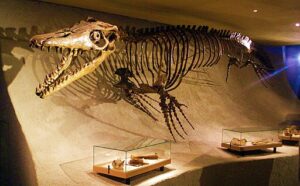Mosasaurus
- When: Late Cretaceous
(82–66 mya) - Where: Worldwide
- What: Mosasaur squamate
- Weight: 15 metric tons
- Length: 12–17 meters
- Diet: Carnivorous
- Discovered: 1822
Squamates are a diverse group of reptiles that include lizards, snakes, and amphisbaenians (worm lizards). They are the largest order of reptiles, with over 10,000 species found all around the world. Squamates are characterized by their scaly skin, which helps protect them and reduce water loss, making them well-adapted to various environments, from deserts to forests.
One of the fascinating features of squamates is their ability to shed their skin periodically. This process, called ecdysis, allows them to grow and get rid of parasites. Squamates have a wide range of diets, including insects, plants, small mammals, and birds, depending on the species. Some, like snakes, have developed venom to subdue their prey, while others rely on speed, camouflage, or strength.
Squamates have unique adaptations such as flexible jaws in snakes, which allow them to swallow prey much larger than their heads, and the ability to regenerate lost tails in many lizards. These adaptations have enabled squamates to become one of the most successful groups of reptiles, thriving in almost every habitat on Earth.

